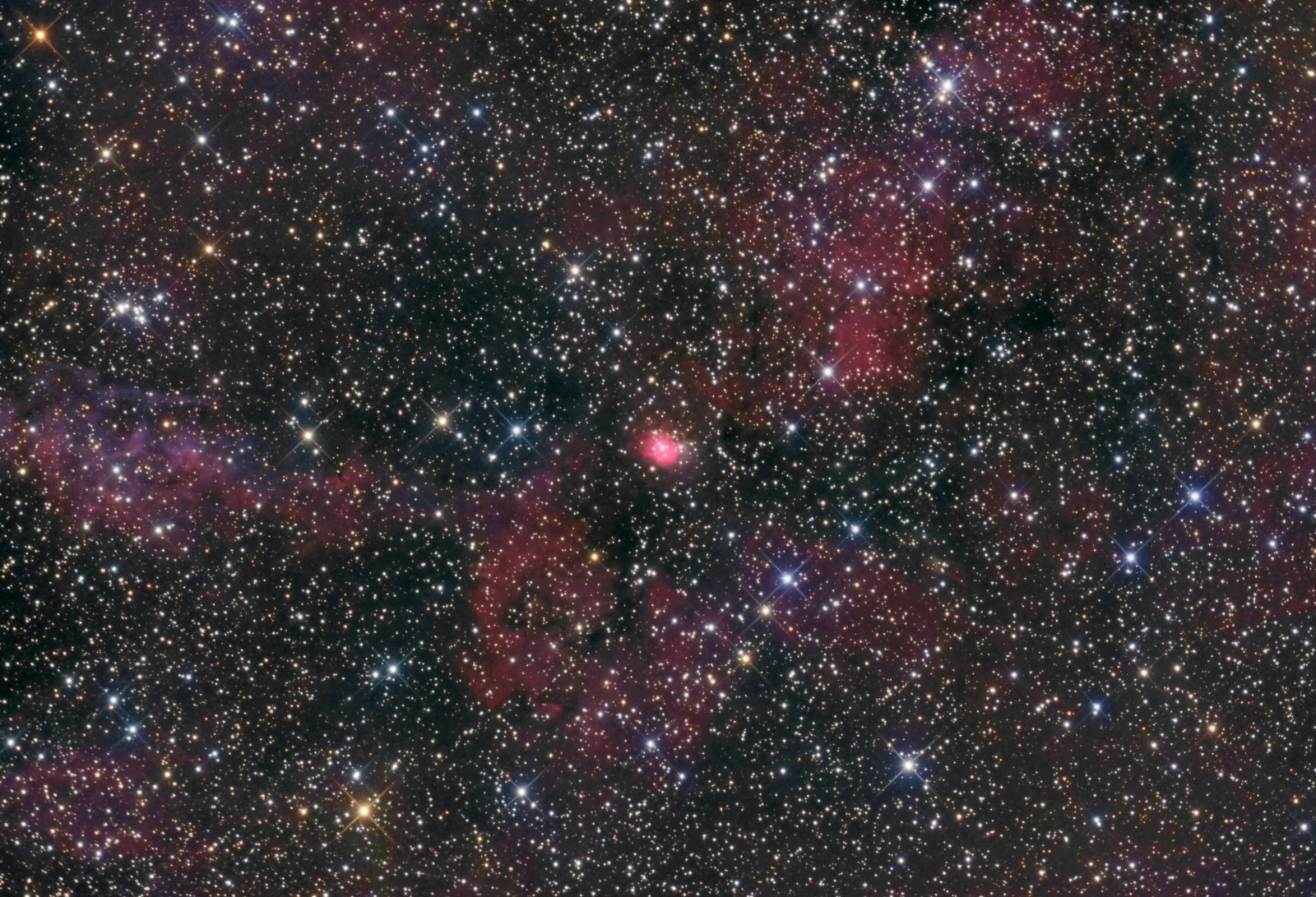Sh2-157
Click image for full size version
November 21, 2015
Sh2-157 is a small emission nebula in Cassiopeia, surrounded by a huge area of fainter nebulosity known as the Claw Nebula, only a part of which appears in this image. Sh2-157 forms a triangle with the Bubble Nebula and NGC7538 in this busy part of the sky. For this image I used only red, green and blue filters, choosing to not use my H-alpha filter in order to avoid overwhelming the subtle blue hues in the fainter portions of the nebula. I was not able to find much information specifically about this object, just about the better known nebulae in the area. An Italian citation on Wikipedia reports that it is a little more than 11,000 light years away.
Tekkies:
SBIG STL-11000M camera, Baader R, G and B filters, 10″ f/6.8 ASA astrograph, Paramount MX. Guided with QHY5 camera and 80 mm f/6 Stellar-Vue refractor. Acquisition and guiding with TheSkyX. Focusing with FocusMax. Automation with CCDCommander. Calibration, cosmetic correction, registration, integration and all processing in PixInsight. Shot from my SkyShed in Guelph, Ontario. No significant moonlight. Good transparency and fair seeing throughout acquisition.
14x15m R, 14x15mG and 12x15mB unbinned frames (total=10hr).
RGB
Creation and cleanup: The BatchPreprocessing script was used to create R, G and B masters. These were combined with ChannelCombination, and the resulting RGB image was cropped and processed with ABE, followed by ColorCalibration.
Linear Noise Reduction: MultiscaleLinearTransform was used to reduce noise in the background areas of the RGB image. Layer settings for threshold and strength: Layer 1: 3.0, 0.5 Layer 2: 2.0, 0.39 Layer 3: 1.0, 0.25 Layer 4: 0.5, 0.1. A mask was used to protect high signal areas.
Stretching: HistogramTransformation was applied to make a pleasing yet bright RGB image. TGV Noise was applied and the image was re-stretched to reset the black point.
Synthetic Luminance
Creation and cleanup: The cropped R,G and B masters were combined using the ImageIntegration tool (average, additive with scaling, noise evaluation, iterative K-sigma / biweight midvariance, no pixel rejection) to create the SynthL channel. ABE was applied with default settings.
Deconvolution: A copy of SynthL was stretched to use as a deconvolution mask. A star mask was made from unstretched SynthL to use as a local deringing support. Deconvolution was applied (100 iterations, regularized Richardson-Lucy, external PSF made using DynamicPSF tool with about 20 stars; local deringing at 70% and global dark deringing at 0.03).
Linear Noise Reduction: MultiscaleLinearTransform was applied to reduce the noise. Layer settings for threshold and strength: Layer 1: 3.0, 0.6 Layer 2: 2.0, 0.5 Layer 3: 1.0, 0.4 Layer 4: 0.5, 0.15
Stretching: HistogramTransformation was applied to make an image with similar brightness to the RGB image. TGV Noise was applied using a mask to protect high-signal areas and the image was re-stretched to reset the black point.
Combining SynthL with RGB:
The luminance channel of the RGB image was extracted, processed and then added back into the RGB image as follows:
1. Extract luminance from the RGB image.
2. Apply LinearFit using SynthL as the reference.
3. Use ChannelCombination in Lab mode to replace the RGB’s luminance with the fitted luminance from step 2.
4. LRGBCombine was then used to make a SynthLRGB image.
Final Processing
SynthLRGB: Overall contrast and brightness and saturation of the nebula were increased slightly with the Curves tool. Stars were tightened up and their sizes reduced with MorphologicalTransformation (morphological selection mode with a setting of 0.16, a kernel of 7px and a circular PSF).
Image scale is about 1.1 arcsec per pixel for this camera / telescope combination.







Leave A Comment